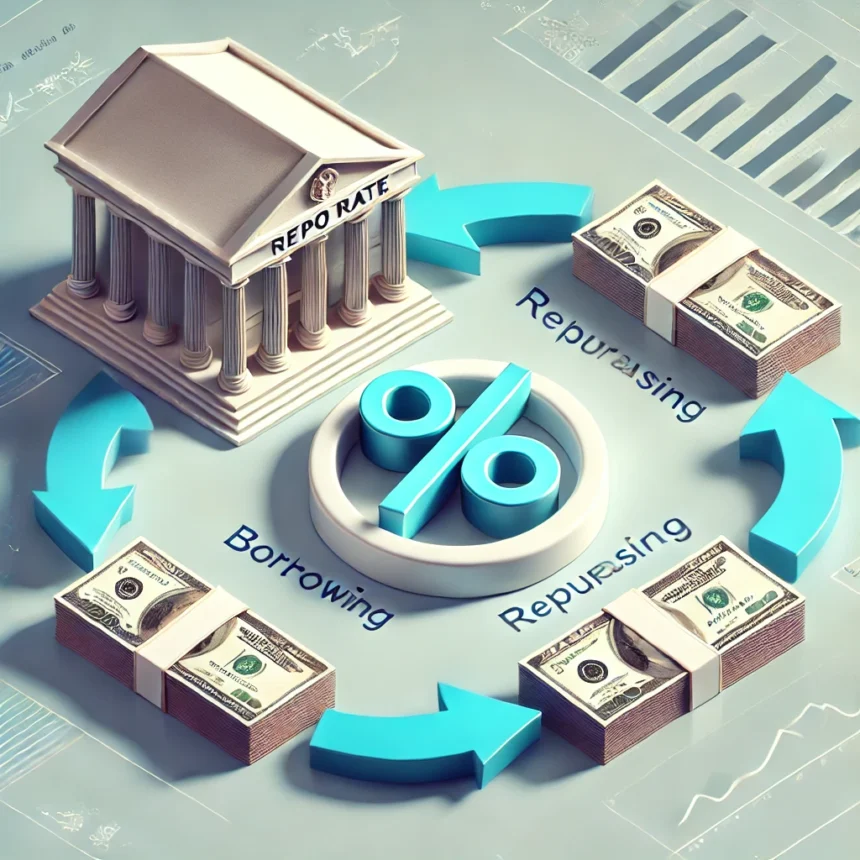The Repo Rate (short for “Repurchase Rate”) is one of the most significant tools used by central banks to regulate liquidity, control inflation, and maintain economic stability. This rate directly influences borrowing costs in the economy and serves as a benchmark for monetary policy.
What is the Repo Rate?
The Repo Rate is the interest rate at which a country’s central bank lends money to commercial banks for short-term needs, typically against the pledge of government securities. The name “repo” originates from “repurchase agreement,” where the central bank provides funds and the commercial bank agrees to repurchase the securities at a future date.
How Does the Repo Rate Work?
- Liquidity Management:
Commercial banks often face liquidity shortfalls and need short-term borrowing to meet reserve requirements or operational needs. The repo rate dictates how much it will cost them to borrow from the central bank. - Pledged Collateral:
Banks pledge government securities as collateral to the central bank in exchange for funds. This ensures a secure transaction and minimizes risks. - Short-Term Duration:
Repo transactions typically last for short durations, such as overnight or a few days, but they play a critical role in maintaining market stability. - Cost of Borrowing:
The repo rate determines the cost of borrowing for commercial banks, which, in turn, affects the interest rates they charge on loans and credit to businesses and consumers.
Importance of the Repo Rate
- Inflation Control:
- High Inflation: Central banks increase the repo rate to make borrowing more expensive, reducing money supply and curbing inflation.
- Low Inflation: Lowering the repo rate makes borrowing cheaper, encouraging spending and investment to stimulate economic activity.
- Monetary Policy Tool:
The repo rate is a key instrument in a central bank’s monetary policy, influencing liquidity, credit availability, and economic growth. - Benchmark Rate:
It serves as a reference for determining other interest rates in the economy, including bank lending rates and deposit rates. - Signal to Markets:
Adjustments in the repo rate indicate the central bank’s stance on inflation and economic growth, influencing investor and market behavior.
Repo Rate vs. Reverse Repo Rate
The Reverse Repo Rate is the opposite of the repo rate. It is the rate at which commercial banks lend funds to the central bank, typically by buying government securities. While the repo rate injects liquidity into the banking system, the reverse repo rate absorbs excess liquidity.
| Aspect | Repo Rate | Reverse Repo Rate |
|---|---|---|
| Purpose | Borrowing by banks | Lending by banks |
| Impact | Infuses liquidity into the system | Absorbs liquidity from the system |
| Economic Scenario | Used in inflationary conditions to manage credit availability | Used to manage surplus liquidity in deflationary scenarios |
Factors Influencing Repo Rate Decisions
Central banks consider several factors when deciding on the repo rate:
- Inflation:
Keeping inflation within the target range is a primary objective of central banks. An increase in the repo rate is used to control inflation, while a decrease stimulates growth. - Economic Growth:
The repo rate is adjusted to encourage or moderate economic growth depending on the prevailing economic conditions. - Global Economic Trends:
Global factors, such as international trade, oil prices, and financial market conditions, can influence repo rate decisions. - Liquidity in Banking System:
The central bank assesses the liquidity position of commercial banks and the broader financial system before adjusting the repo rate.
Impact of Repo Rate on the Economy
- For Borrowers:
Changes in the repo rate influence loan and credit card interest rates. A higher repo rate makes loans more expensive, while a lower rate reduces borrowing costs. - For Savers:
A higher repo rate can lead to higher interest rates on savings accounts and fixed deposits, benefiting savers. - For Businesses:
A lower repo rate reduces borrowing costs for businesses, encouraging capital investment, while a higher rate can deter spending. - For Stock Markets:
Lower repo rates generally boost equity markets by increasing liquidity and reducing the cost of capital. - For Currency:
Changes in the repo rate can affect foreign exchange rates. A higher rate may attract foreign investment, strengthening the domestic currency.
Real-World Examples
- India’s Repo Rate:
The Reserve Bank of India (RBI) adjusts the repo rate periodically to align with inflation targets and economic growth objectives. For instance, during periods of high inflation, the RBI raises the repo rate to contain excessive spending. - United States’ Federal Funds Rate:
While not called a “repo rate,” the Federal Reserve’s target interest rate functions similarly by influencing liquidity and economic activity.
Challenges and Limitations
- Delayed Effect:
Repo rate changes take time to influence the economy, creating a lag between implementation and impact. - External Dependencies:
Domestic repo rate adjustments may be less effective if global economic conditions, such as recessions or trade imbalances, dominate. - Balancing Inflation and Growth:
Striking a balance between controlling inflation and promoting economic growth is a challenging task for central banks.
Conclusion
The repo rate is a fundamental tool in a central bank’s arsenal for managing economic stability. By influencing liquidity, borrowing costs, and spending behavior, it has a cascading effect on all sectors of the economy. While it is not without its challenges, effective repo rate management can ensure a stable and thriving economic environment. For individuals and businesses alike, understanding the repo rate provides insights into interest rate trends and helps in financial planning.




